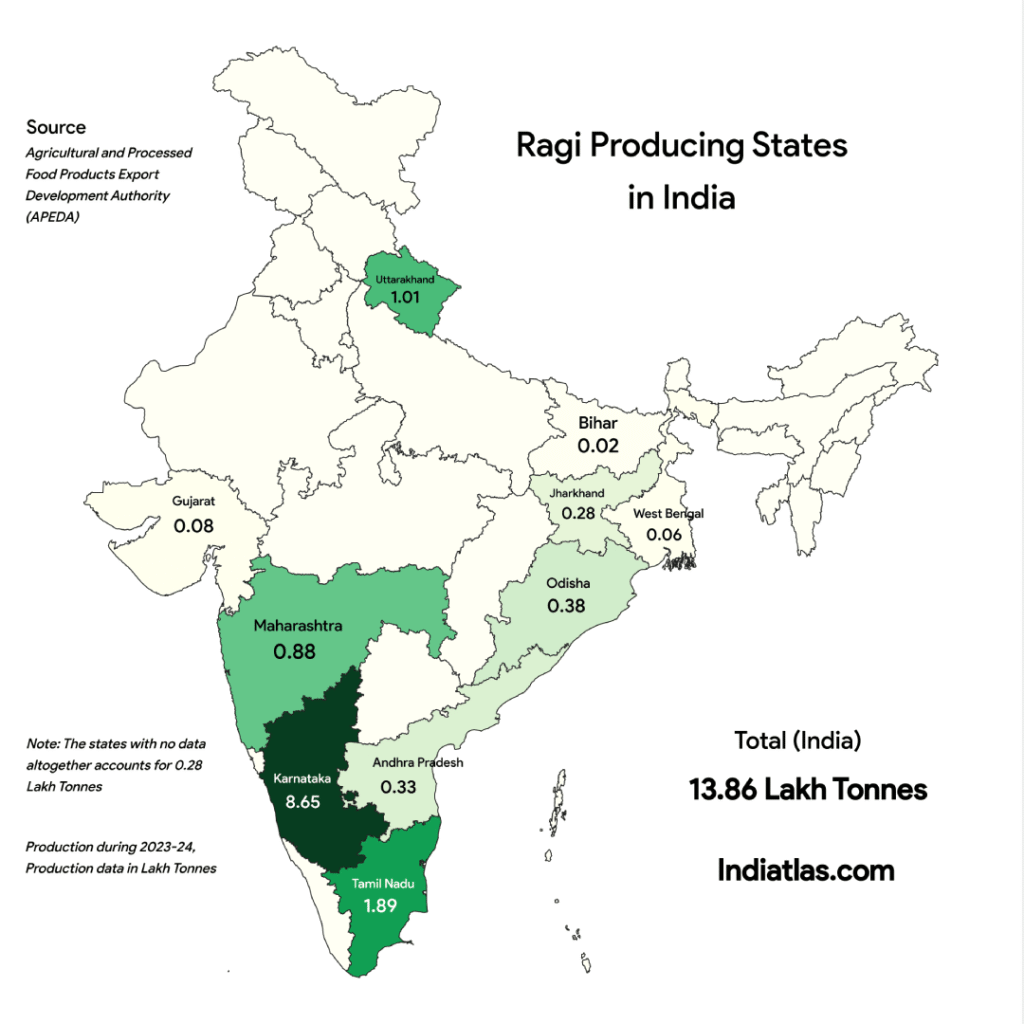Across India’s diverse agricultural landscape, the ragi producing states in India have emerged as critical players in the quest for sustainable agriculture and enhancing the nutritional security in rural India.
The total ragi production in India is currently 13,86,000 Tonnes (1.386 million Tonnes), and most of it comes from two states, Karnataka and Tamil Nadu. These two states collectively account for over 75% of the total Ragi output. Of them, Karnataka alone contributes 62%.
Ragi, also known as Finger Millet, has gained significant importance in recent years as a promising future crop due to its exceptional resilience in semi-arid climates, high nutritional profile, and pest-resistant nature.
The awareness campaign on ragi as a smart food helped make it a staple diet for consumption among many Indian households.
Additionally, this increased interest led to the development of several food products centred around ragi, creating new revenue streams.
In light of the above, let us look into those ragi producing states in India.

| State | Ragi Production (in Lakh Tonnes) | Percentage Share | Ragi Yield per hectare |
|---|---|---|---|
| Karnataka | 8.65 | 62.40% | 1268 |
| Tamil Nadu | 1.89 | 13.63% | 2989 |
| Uttarakhand | 1.01 | 7.28% | 1469 |
| Maharashtra | 0.88 | 6.34% | 1251 |
| Odisha | 0.38 | 2.74% | 839 |
| Andhra Pradesh | 0.33 | 2.38% | 1222 |
| Jharkhand | 0.28 | 2.02% | 918 |
| Gujarat | 0.08 | 0.57% | 802 |
| West Bengal | 0.06 | 0.43% | 1177 |
| Bihar | 0.02 | 0.14% | 924 |

1. Karnataka
With a production of 8.65 lakh tonnes (8,65,000 tonnes) of Ragi, Karnataka is the largest Ragi producing state in India, accounting for 62.40% of total Ragi production in the country.
Presence of the semi-arid climate, well-drained soils, and moderate rainfall in the southern part of Karnataka makes it a perfect region for the cultivation of Ragi. Along with these, the strong cultural reliance on ragi as a staple food has made Karnataka the backbone of India’s ragi cultivation.
The cultivation of this crop spans 10,000 hectares in Karnataka, where farmers have obtained an average yield of 1,268 kg per hectare.
Tumakuru, Mysuru, Ramanagaram, Bengaluru Rural, Kolar, Mandya, Kalaburagi, and Chikkaballapur are the key districts known for ragi production.
Drought-tolerant and pest-resistant nature is one of the main reasons why farmers prefer Ragi or millets over other crops in this region.
The state government actively promotes ragi cultivation through various programs, such as procurement under the minimum support price (MSP) and incorporating ragi into the public distribution system.
Furthermore, Karnataka stands third among the top millet producing states in India and second in Jowar production, highlighting its importance in the cultivation of millets.
2. Tamil Nadu
Tamil Nadu stands as the second among the ragi producing states in India, with a production of 1.89 lakh tonnes (1,89,000 tonnes) in 2023-24. This accounts for 13.63% of the nation’s output.
Regarding ragi yield, Tamil Nadu is the most productive of all the states, with an average yield of 2989 kg of ragi per hectare.
Mostly, ragi is grown as a rainfed crop in the semi-arid regions of this state.
Krishnagiri, Dharmapuri, Tirupathur, Erode, Salem, Tiruvannamalai and Vellore are the districts where most Ragi is cultivated in the state. Among these, Krishnagiri itself contributes more than 40% of the Ragi.
Households across the region use ragi to make various traditional dishes and consume it as a staple food.
State government and non-profit organizations are promoting millet as a nutrient-rich food as well as a part of national security. These awareness programs further boosted the consumption and cultivation of Ragi in the State.
3. Uttarakhand
Among the Northern Indian states, Uttarakhand is a significant producer of ragi and ranks third among all Indian states.
It has produced 1.01 lakh tonnes (1,01,000 tonnes) of Ragi during 2023-24, which accounts for 7.28% of total Ragi output in the country.
Ragi yield per hectare is also significant, and the average yield of ragi for 2023-24 is at 1469 kg per hectare.
It is one of the traditional crops cultivated in this region and consumed as a staple food in many households.
Cultivated in mixed cropping patterns, Ragi is grown mainly in the hilly regions and plains of Garhwal and Kumaunthe regions.
Ragi cultivation thrives in the districts of Almora, Chamoli, Champawat, Tehri, Uttarkashi, and Bageshwar in Uttarakhand.
Low availability of high-yielding ragi seeds and fertilisers that can fix micronutrient disorders are the main challenges faced by farmers in ragi cultivation.
The Uttarakhand Government has taken several steps to promote organic cultivation of millets. Additionally, the government launched the state millet mission in 2023, aiming mainly to provide subsidies on seeds and also to improve market linkages.
4. Maharashtra
During the 2023-24 season, Maharashtra achieved a production of 0.88 lakh tonnes of Ragi, placing it fourth among ragi producing states in India and accounting for 6.34% of the country’s total output.
Farmers cultivated ragi on 70000 hectares of land in this state, achieving an average yield of 1251 kg per hectare.
Kolhapur, Nasik, Palghar, Ratnagiri, Satara, Thane, and Raigad are the significant ragi producing districts in Maharashtra.
The presence of hot and dry climate, less rainfall and a unique soil profile in the western part of the state has made farmers choose ragi over other crops in that region.
The State Government has taken several initiatives to promote awareness of millets and to increase the cultivation through the Millet Mission. Also, the government is implementing an integrated cereal development programme under which they are providing assistance in the distribution of certified ragi seeds.
An interesting fact is that Maharashtra stands at the top among the Jowar producing states in India and sixth among the Bajra producing states.
5. Odisha
Odisha had produced 0.38 lakh tonnes of Ragi during 2023-24 and stands fifth among the Ragi producing states in India in terms of production.
This millet is cultivated in 46,000 hectares of land, yielding 839 kg per hectare on average.
Despite the low yields, ragi is highly valued in this region due to its cultural significance in several communities of the state.
Ragi’s ability to grow in less fertile soils and tolerance to drought make it an ideal crop for local farmers.
Small tribal and rural farmers primarily cultivate this crop in the hilly and rainfed regions of the state.
Koraput, Ganjam, Rayagada, Malkangiri, and Gajapati are the major ragi producing districts in Odisha.
Government has taken several initiatives to support Ragi cultivation and farmers, primarily by procuring ragi from tribal areas and by providing minimum support prices.
6. Andhra Pradesh
Standing sixth in the list, Andhra Pradesh accounts for 2.38% of the nation’s share with a production of 0.33 lakh tonnes of ragi.
During 2023-24, ragi was cultivated on 27,000 hectares of land and yielded 1,222 kg per hectare.
Ragi and other millets have long been a staple food in the Rayalaseema region of the state.
Innovative practices by farmers in Andhra Pradesh, such as the adoption of the Guli or Netti method for cultivating ragi, have increased the crop’s yield.
Sri Satya Sai, Anantapuram, Prakasam, Srikakulam, Alluri Sitharama Raju, and Chittoor are the key districts where most ragi get cultivated.
There are several ongoing efforts by the State government and non-profit organizations to improve the yield and quality of the produce by natural farming.
Awareness programmes on millets by health activists in the state have also shown a positive impact.
7. Jharkhand
With a production of 0.28 lakh tonnes of Ragi for 2023-24, the state of Jharkhand accounts for 2.02% of India’s Ragi output.
In Jharkhand, ragi is mainly cultivated in tribal-dominated districts. In 2023-24, this crop was grown in 31000 hectares of land, and the average yield obtained is 918 Kg per hectare.
Gumla, Ranchi, Khunti, Jamtara, Simdega, and West Singhbhum are the popular ragi cultivating districts in the state.
The success story of the Gulma district in cultivating ragi is an inspiring story for all other states.
A young diplomat launched an initiative to cultivate ragi in those districts, successfully convincing thousands of farmers to switch to ragi cultivation, which would be more sustainable.
This resulted in a remarkable 217% increase in ragi cultivation from 3500 hectares in 2022-23 to 11,100 hectares in 2023-24.
8. Gujarat
With a production of 0.08 lakh tonnes (8000 tonnes) of Ragi in 2023-24 and accounting for 0.57% of the total ragi output, Gujarat stands eighth on the list.
Despite the consistent cultivation area (10,000 hectares), the production of Ragi in Gujarat declined substantially in the past few years, with the production of 10000 tonnes in 2019-20 and 13,000 tonnes in 2020-21. This is mainly due to the decline in yield.
Currently, Ragi’s yield on average per hectare is at 802 Kg.
Dang and Valsad are the two districts where ragi are cultivated in the state. Around 99% of Ragi is cultivated in these districts alone.
The Gujarat Government has taken several steps in developing millet value-added products.
9. West Bengal
Standing ninth among the Ragi Producing states in India, West Bengal produces 0.06 lakh tonnes (6000 tonnes) of Ragi, which accounts for 0.43% of the nation’s share.
Darjeeling and Kalimpong are the two major districts where most ragi cultivation takes place in the state. Cultivated on 5000 hectares, the average yield stands at 1177 Kg per hectare.
10. Bihar
Although not significant in terms of production, Bihar holds importance as the cultivation of Ragi is very low in northern India.
Bihar produces 0.02 lakh tonnes (2000 tonnes) of ragi, accounting for 0.14% of the ragi production in India. The Average yield rate per hectare stands at 924 kg.
Siwan, Supaul, Saharsa, Darbhanga and Madhubani are the main ragi-cultivating districts in Bihar.
Other Ragi Producing States in India
All other ragi producing states, along with union territories, contribute to 28,000 tonnes. Among them, the major ragi producers are
- Arunachal Pradesh – This state is also known for its ragi production. During 2022-23, 28000 tonnes of ragi were produced in this state.
- Chhattisgarh
- Himachal Pradesh
- Kerala









